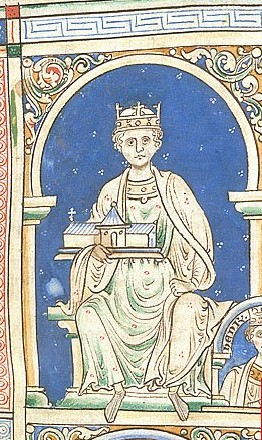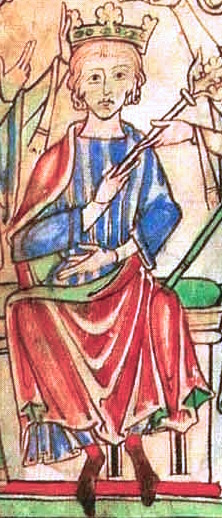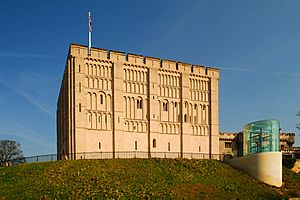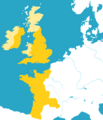Revolt of 1173–1174 facts for kids
The Revolt of 1173–1174 was a big family disagreement against King Henry II of England. His own sons and his wife, Queen Eleanor, joined forces with others who didn't like the King. After about 18 months, the fight ended. King Henry II won, and his family members had to accept his rule again. They made peace with him.
Quick facts for kids Revolt of 1173–1174 |
|||||||||
|---|---|---|---|---|---|---|---|---|---|
 Territory ruled by Henry II |
|||||||||
|
|||||||||
| Belligerents | |||||||||
Kingdom of Scotland Duchy of Brittany County of Flanders County of Boulogne |
|||||||||
| Commanders and leaders | |||||||||
Ranulf de Glanvill Reginald de Dunstanville William FitzRobert William d'Aubigny Geoffrey Fitzroy |
|||||||||
Contents
Why Did the Family Fight?

King Henry II had been ruling England, Normandy, and Anjou since 1154. His wife, Queen Eleanor, ruled the huge area of Aquitaine since 1137.
In 1173, Henry II had four sons:
- Henry, often called the "Young King"
- Richard (who later became known as "the Lionheart")
- Geoffrey
- John ("Lackland")
These sons were all set to inherit parts of their father's lands. Henry also had an older son, Geoffrey, who was born before his marriage.
The Young King's Desire for Power

Henry the Young King was 18 years old and very popular. He was married to the daughter of Louis VII of France, who was Queen Eleanor's first husband. The Young King had many knights and followers, but he didn't have enough money or land to reward them. He really wanted to rule some of his family's lands on his own.
What Started the Rebellion?
The main reason for the rebellion was King Henry II's decision to give three castles to his youngest son, John. These castles were supposed to be part of the Young King's future inheritance. This made the Young King very angry.
Many important people encouraged the Young King to rebel. They thought they could gain power and wealth if there was a change in who ruled. His mother, Queen Eleanor, was also having arguments with King Henry II and joined her sons. Other people were upset with King Henry II because of the death of Archbishop Thomas Becket in 1170. This event made many people across Europe dislike Henry II.
Forming an Alliance Against the King
In March 1173, the Young King went to the court of his father-in-law, King Louis VII of France. His brothers, Richard and Geoffrey, soon followed him. Queen Eleanor tried to join them, but King Henry II stopped her and kept her captive.
The Young King and King Louis VII created a large alliance against Henry II. They promised land and money in England and Anjou to other powerful leaders:
- The Counts of Flanders
- The Counts of Boulogne
- The Counts of Blois
- William the Lion, the King of the Scots, was promised Northumberland.
The Young King planned to take his inheritance by breaking apart his father's lands.
The Fight Begins
The fighting started in April 1173.
- The Counts of Flanders and Boulogne attacked Normandy from the east.
- The King of France and the Young Henry attacked from the south.
- The Bretons attacked from the west.
All these attacks failed. The Count of Boulogne was killed. King Louis was defeated and pushed out of Normandy. The Bretons lost many soldiers and much treasure. King William the Lion's attacks in northern England also failed. King Henry II tried to talk with his son, the Young King, in Normandy, but they couldn't agree.
Rebels in England
The Earl of Leicester was a strong supporter of the Young King and a leader of the rebel nobles. He gathered an army of soldiers from Flanders and crossed from Normandy to England. He planned to join other rebel leaders there, especially Hugh Bigod, the Earl of Norfolk.
However, the Earl of Leicester's army was stopped by English forces returning from Scotland, led by Richard de Luci. The Earl of Leicester's army was completely defeated at the Battle of Fornham. King Henry II's loyal supporters supposedly said to him, "It is a bad year for your enemies."

In the spring of 1174, the rebellion continued. David, Earl of Huntingdon, who was King William the Lion's brother, moved south to try and conquer northern England. He became the new leader of the rebel nobles. William de Ferrers, the Earl of Derby and another rebel, burned the royal town of Nottingham. Hugh Bigod also burned Norwich.
Henry II's Return and Victory
King Henry II, who had been fighting his enemies in Normandy, landed in England on July 8. His first action was to show his sorrow for the death of Thomas Becket. Becket had been killed by some of Henry's knights three years earlier and was now considered a saint.
The very next day, July 13, something amazing happened for Henry II. King William the Lion and many of his supporters were surprised and captured at the Battle of Alnwick by a small group of loyal soldiers. After this big win, Henry II was able to quickly defeat the remaining rebels. He marched through each rebel stronghold, and they all surrendered to him.
With England under control, Henry II went back to Normandy to make peace with his enemies. On September 30, "King Henry, the king's son, and his brothers, returned to their father and to his service, as their lord." The rebellion was over.
What Happened After?

The revolt lasted for 18 months and spread across a huge area, from southern Scotland all the way to Brittany. At least 20 castles in England were torn down by the king's orders after the rebellion. Many towns were destroyed, and many people lost their lives.
People blamed the Young King's advisors, the rebel nobles. They believed these nobles had tricked the young and inexperienced princes for their own selfish reasons. William Marshal, who stayed loyal to the Young King during the revolt, later said, "cursed be the day when the traitors schemed to embroil the father and the son."
Images for kids






